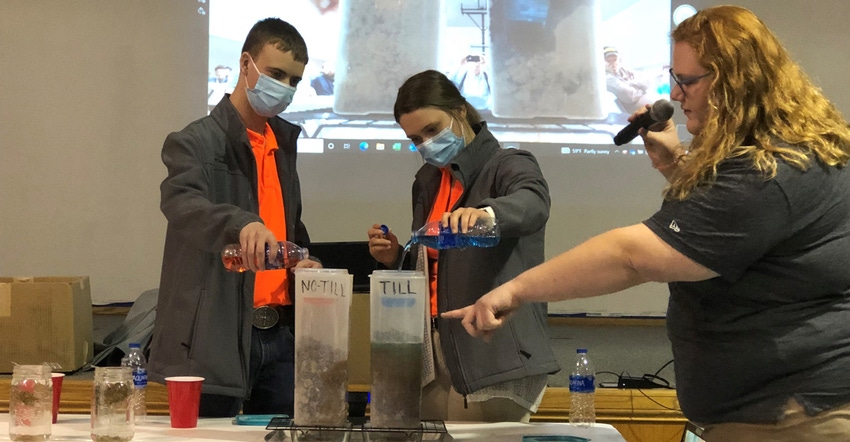
You’ve likely seen soil conservation personnel show how no-till soils handle water differently. But have you ever seen FFA members demonstrate it?
The soil infiltration demonstration at the Ripley County Soil and Water Conservation District annual no-till breakfast was unique. Mark Thomas, a soil conservation specialist with the Division of Soil Conservation in the Indiana State Department of Agriculture, introduced his daughter, Jessica Thomas. She is a senior at South Ripley High School and 2021-22 District 12 FFA president.
“I have two FFA members helping me,” Jessica Thomas told the crowd of over 100 farmers. Her helpers were Abby Stuckwisch, 2021-22 Indiana FFA state secretary, and Tyler Kilmer, 2021-22 northern region vice president.
“We have two columns of soil — the one on the left is from a long-term no-till field, and the one on the right is from a conventional tillage field,” she explained. “They’re going to pour bottles of colored water onto the surface. Notice what happens to the water.”
Seeing can be difficult with demonstrations, but not this time. Computer technology let the FFA members project the image live on a big screen behind Stuckwisch and Kilmer.
“Notice where the water in each container is now,” Thomas continued. “In the one on the right representing a tilled field, it’s like concrete on top, and water is having trouble moving through into the soil.
“Look at the no-till container on the left. See how water has moved into the profile. Pores and channels allow water to filter through the topsoil.”
If these were real fields, she noted, water would sit on the surface in conventional tillage, resulting in ponding. In no-till, water would soak in quickly with little, if any, ponding — and little, if any runoff, she said. Instead, water would be held in the subsoil and available for plants for a longer period.
The FFA team demonstrated what farmers often report seeing after big rains. Don Rekeweg, a retired farmer and landowner in Allen County, Ind., carries pictures on his phone to prove this point.
He stood in the road after a big rain event and took a picture of the neighbor’s field, with water ponding on top. Then he photographed his field, with no water on top.
“It’s a no-till field, and water infiltrated into the soil,” he says proudly.
Read more about:
No tillAbout the Author(s)
You May Also Like




